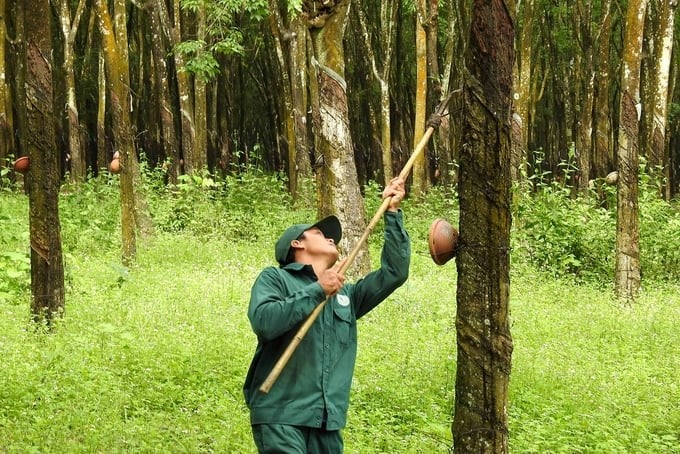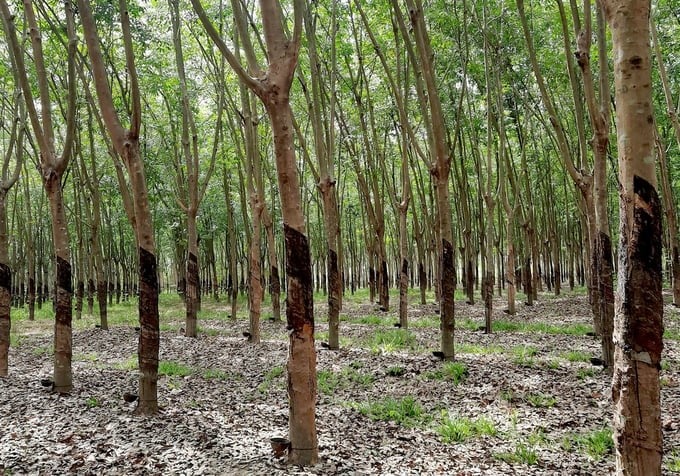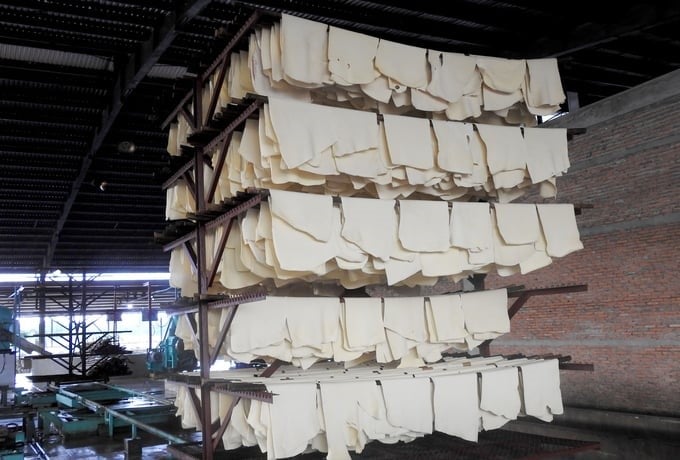November 24, 2025 | 13:33 GMT +7
November 24, 2025 | 13:33 GMT +7
Hotline: 0913.378.918
November 24, 2025 | 13:33 GMT +7
Hotline: 0913.378.918

80% of VRG's rubber area in Vietnam has been granted the certificate of sustainable forest management. Photo: Thanh Son.
Recently, the Vietnam Rubber Association (VRA) coordinated with Forest Trends to organize the workshop "Current Situation of the Supply Chain of Vietnam's Rubber Industry: Preparing to Meet the European Deforestation-Free Regulation." Sharing at the workshop, the representative of Casumina said that for many years, the company has exported tires to Europe. A few months ago, several European importers emailed Casumina, noting that the company must prepare to meet EUDR regulations for tire products and natural rubber-derived products exported to the EU market.
Information from Casumina shows that even though it is more than half a year before EUDR is officially applied to large enterprises, European importers have been deeply concerned about this regulation.
According to Mr. Vo Hoang An, Secretary General of VRA, the EU is Vietnam's third largest export market for rubber products. In 2023, Vietnam's export turnover of rubber products to the EU reached USD 469 million, equivalent to 6.5% of the whole industry's export turnover of rubber products (raw rubber and rubber products).
With the above export turnover, it can be seen that the EU is an important market for Vietnam's rubber industry.
Not only that, Vietnamese rubber is now mainly exported to China and is the second largest supply source for this market. As the world's leading importer of raw rubber and processor of finished rubber products, China is a large supplier of rubber products for the EU. Therefore, it is possible that an amount of natural rubber from Vietnam is processed in China and then exported as a final product to the EU.
When finished rubber products from China exported to the EU must comply with the EUDR, Chinese traders certainly also require Vietnamese raw rubber exporters to meet this regulation when selling to them.
In complying with the EUDR, while it is possible to rest assured about large plantation rubber, concerns focus on imported natural rubber sources and smallholder rubber.

A smallholder rubber garden in Binh Phuoc. Photo: Thanh Son.
Natural rubber imported into Vietnam mainly comes from Cambodia, Laos, etc. In 2023, Vietnam imported nearly 1.4 million tons of natural rubber, with a turnover of approximately USD 1.4 billion. Smallholder rubber currently accounts for over 50% of total domestic natural rubber output.
Mr. Nguyen Vinh Quang, policy analyst at Forest Trends, said that for natural rubber imported from Cambodia and Laos, current information does not allow traceability. Information about the supply chain from these two sources to Vietnam is very limited.
For smallholder rubber, traceability is very difficult because the supply chain is very complex. Smallholder rubber purchasing is mainly undertaken by traders or commercial companies at many levels (village, commune, district, province) and is spontaneous, with many intermediaries buying and reselling. There are many farmers who both grow rubber and act as rubber purchasing agents for other households. Recording of resale activities is not done adequately. Besides, there is a lack of information about issuing land use rights certificates for smallholder rubber. Even some areas have not been issued land use rights certificates or are still in dispute or overlapping.
Faced with that situation, Forest Trends recommends that rubber companies re-evaluate all supply sources and strictly implement traceability for domestic supply sources. At the same time, have mechanisms, policies, incentives, and support for parties involved in the smallholder rubber supply chain to be trained, thereby promoting compliance and ensuring traceability, software development and application, digitization, etc. In addition, it is necessary to collect information, be transparent about imported supply sources, and separate imported supply sources of unknown origin from domestic sources with clear origins.

VRG's rubber latex is produced at a factory in Cambodia. Photo: Thanh Son.
As a unit that has raw rubber sources from abroad and purchases a lot of smallholder rubber, Vietnam Rubber Group (VRG) is paying attention to these issues.
According to Mr. Truong Minh Trung, Deputy General Director of VRG, the Group currently has many member companies that are growing rubber in Cambodia and Laos. Because Cambodia and Laos do not have a sustainable forest certificate management system like in Vietnam, VRG has proactively built a traceability system for rubber latex and rubber wood products in the Group's rubber gardens in these two countries.
Each year, VRG’s member companies buy about 100,000 tons of smallholder rubber. VRG has a plan to support smallholder rubber growers in building digital maps according to EUDR requirements on traceability.
As for the rubber area in Vietnam managed by VRG, as of now, about 80% have been granted the VFCS/PEFC-FM certificate of sustainable forest management, thereby helping the Group basically meet EUDR requirements on traceability. VRG is striving to ensure that by 2025, the entire area of Vietnam will achieve this certificate.
Translated by Thu Huyen
/2025/11/21/4309-2-153400_128.jpg)
(VAN) Green and low-emission rice is paving the way for Vietnamese rice to enter high-end markets, marking the beginning of a transformation journey toward greening and elevating the national rice brand.

(VAN) ‘Right to Win’ outlines a national action plan that shapes a new vision for Viet Nam’s agriculture in an era of renewal and global integration.

(VAN) Lam Dong’s farmed sturgeon output this year is expected to reach 2,300 tons, worth VND 450 billion, affirming the brand’s position on the market.

(VAN) A surge in Ukrainian egg exports, largely driven by soaring sales to the UK over the last few years, has notably pushed up egg prices on the domestic market.

(VAN) The price of Arabica Catimor coffee in Quang Tri is currently at VND 25,000–27,000/kg (fresh cherries), the highest level ever recorded

(VAN) 'From the coffee story, we can think deeper and further about the crop production sector - from development orientations and value-chain organization to international integration,' assessed Dr Le Quoc Doanh.
/2025/11/18/2431-0-161627_248.jpg)
(VAN) Viet Nam accounts for 43% of the world's export volume of Robusta coffee. However, the Vietnamese Robusta coffee brand has yet to gain broad recognition on the global market.